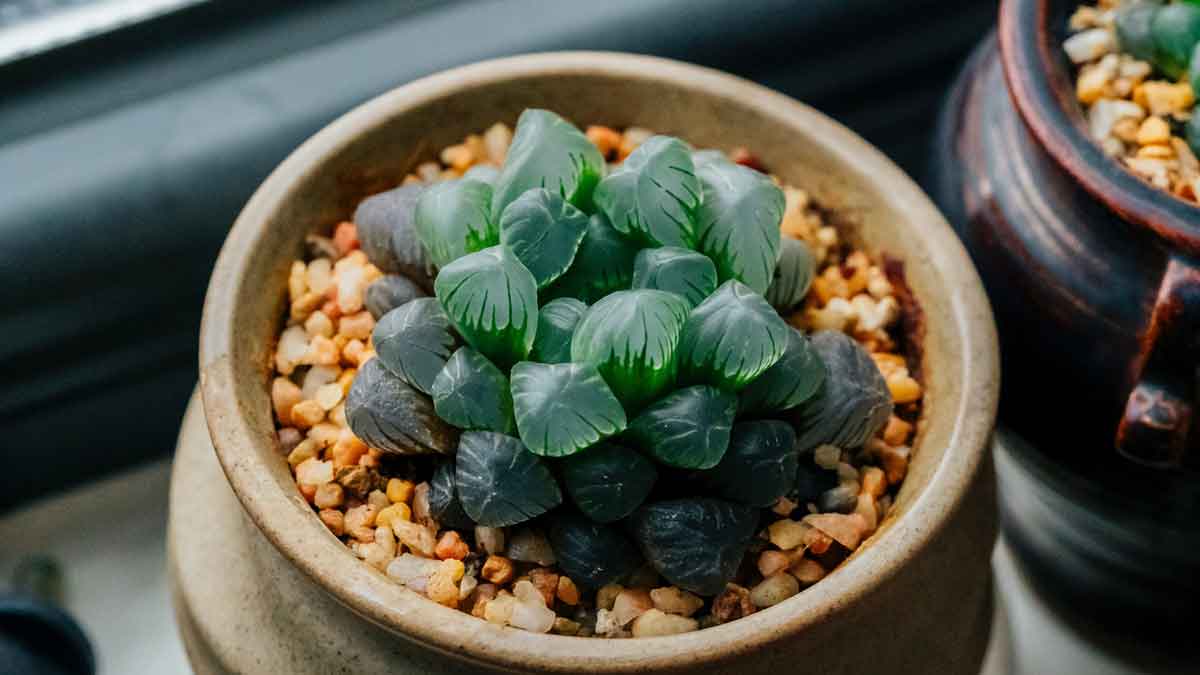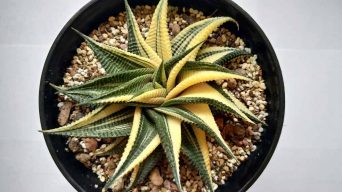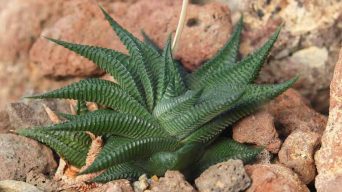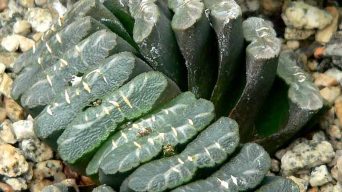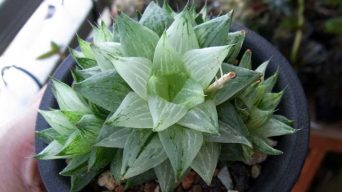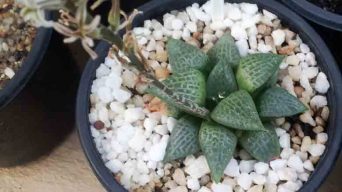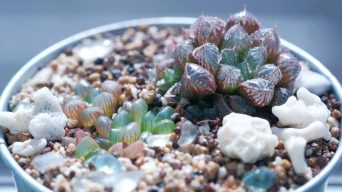Key Takeaways
- Water based on factors like plant size, season, climate, and soil type – There is no universal watering frequency. Adjust for your specific conditions.
- Underwatering causes wrinkled, curled leaves. Overwatering causes mushy, translucent leaves. Observe the plant to avoid both.
- During active growth, a general guideline is watering every 2-4 weeks. In dormancy, scale back to every 3-5 weeks.
- Always allow the soil to dry out slightly between waterings. Use your finger to test soil moisture before adding more.
- Use room temperature rain or distilled water for best results. Soak the soil thoroughly when watering until it drains from the bottom.
With their stunning geometric patterns and a wide array of colors, it’s no wonder Haworthia plants have become so popular among indoor gardeners.
Their compact size makes them perfect for windowsills, while their low maintenance needs appeal to busy folks and beginning plant parents alike.
However, while Haworthia succulents are generally easygoing, there is one area where a bit of attentiveness is required: watering.
Proper watering practices are crucial for ensuring your Haworthia succulent thrives for years.
Understanding the plant’s needs, being aware of signs of distress, and developing a thoughtful watering routine will help prevent the issues that can arise from both under-and overwatering.
The key is balance – staying mindful of environmental factors while allowing the plant’s growth and appearance to guide you.
This guide will cover everything you need to know about how often to water Haworthia plants.
Understanding Haworthia’s Watering Needs
When determining how often to water your Haworthia succulent, it’s essential to consider several factors that affect the plant’s moisture requirements. These include:
Succulent Plant Size and Type
- There are over 80 different Haworthia species with varying water needs. Smaller varieties like H. retusa require less frequent watering than larger, faster-growing species such as H. cooperi.
- The size of the individual plant also matters. A smaller, younger Haworthia in a 4-inch pot dries out quicker than a mature, 8-inch plant—base watering frequency on pot size.
Season and Climate
- In their native South Africa, Haworthias grow during the rainy summer season and become dormant in the dry winters. Mimic this cycle indoors.
- Water more frequently in the active growing period of spring through fall. Reduce watering in winter when growth slows.
- Drier climates require more frequent watering to account for the moisture lost to evaporation. Humid environments need less.
Potting Medium and Container
- A fast-draining cactus mix allows excess moisture to evaporate. Dense or water-retentive soil stays wet for too long.
- Terracotta pots promote evaporation, while plastic holds moisture longer. Use fast-draining potting soil in non-porous pots.
- Larger pots retain more moisture than small ones. Adjust watering accordingly.
Considering these factors, you can determine a baseline frequency for your Haworthia’s needs.
But also pay attention to the plant’s signals and environmental conditions to adjust as needed.
Signs of Underwatering and Overwatering
To dial in the ideal watering routine, it’s important to recognize when your Haworthia is getting too much or too little water.
Here’s what to look for:
Underwatering
- Leaves look wrinkled, thin, and deflated. They might curl inward.
- Growth slows or stops.
- The plant feels light when lifted, and the soil is completely dry.
- Occasional drying out is normal, but leaves shouldn’t stay wrinkled.
Overwatering
- Leaves turn mushy, translucent, almost melting.
- Lower leaves feel soggy or rotten stems appear.
- Excess moisture encourages fungal rot and root disease.
- If the soil stays wet for days, drainage is poor, or the plant gets too much water.
Don’t let the succulent plant sit in prolonged drought, as underwatering and overwatering Haworthia plants can have detrimental effects.
The key is to soak the soil thoroughly when watering, then allow the top inch to dry out before watering again.
Observe your plant closely and adjust as needed to maintain this balance.
Recognizing distress signs early prevents more severe issues down the road.
Creating a Watering Schedule
When caring for any houseplant, it’s helpful to develop a basic watering schedule as a starting point.
Here are some general guidelines for Haworthias:
General Guidelines
Frequency
- During the active growing period of spring through fall, water most Haworthias every 2-4 weeks. Small varieties may need watering every 1-2 weeks.
- In the winter rest period, scale back to watering every 3-5 weeks. Larger plants may go 6-8 weeks between drinks.
Test Before Watering
- To avoid guessing, insert your finger to test the top inch of the soil. If dry, it’s time to water. If still damp, wait a few more days.
- Let the soil approach dryness between waterings, but don’t let it stay parched for prolonged periods.
These schedules are simply a baseline – you’ll need to monitor your succulent plant and adjust it based on its needs.
Use the following tips to customize watering to your Haworthia’s unique situation.
Adjusting Watering for Specific Situations
While the general guidelines provide a starting point, you must fine-tune your watering routine based on your Haworthia’s needs.
Here are some tips for customizing care:
Dormant Period
- During winter dormancy, suspend fertilizing and limit water to only when the leaves start to wrinkle. This is about every 4-6 weeks for most varieties.
- For species like Haworthia truncata that are ultra-dormant in winter, you may water only 2-3 times total! Take care not to overwater dormant plants.
Propagation
- After removing pups or fleshy leaves for propagation, water more frequently while new roots establish. Aim for every 5-7 days.
- Mist the soil daily to provide added humidity. Once roots form, resume normal watering habits. Don’t over-saturate tender new plants.
As you gain experience with your succulent plant, continue observing its growth patterns and signals to determine its seasonal, dormant, and propagation needs.
Adjust as required to keep it thriving!
Humidity Considerations
While temperature plays a key role in Haworthia care, humidity also influences water needs.
If growing these succulents indoors, be aware that most homes and apartments tend to run drier than Haworthias prefer.
To compensate:
- Water more frequently than you would in a naturally humid environment. Aim for every 2-3 weeks instead of 3-4 weeks.
- Use a pebble tray or humidifier nearby to add moisture to the air. Keep humidity around 40-50% if possible.
- Monitor for leaf tip browning and drying, signs that added water applications may be needed in dry air.
For outdoor plants or greenhouses, consider the following:
- Reduce watering frequency if located in a humid, rainy, or coastal climate. Allow the potting mix to dry out more between waterings.
- In arid climates, irrigation may be needed outside of normal watering routines if growing outdoors.
By tracking your local humidity levels throughout the seasons and making adjustments, you can determine an optimal watering regimen tailored to your environment.
Watering During Flowering
One watering consideration unique to Haworthias is adjusting your schedule when the plant sends up flowering stalks.
Here are some tips:
- Haworthias enter a growth spurt when preparing to flower and require more frequent watering for several weeks beforehand.
- During actual flowering, maintain a consistently moist but not soggy soil mix. Avoid drier periods to prevent bud or stalk abortion.
- Immediately after flowering, resume a regular schedule. The succulent will be entering a resting period and shouldn’t be overwatered.
- Remove spent flower stalks by cutting at the base. This encourages the plant to concentrate energy on leaf growth rather than seed production.
With the right water balance during flowering, you can help your Haworthia successfully move through this cyclical life stage.
Pay close attention in the weeks before, during, and after blooming to support healthy growth.
Rainwater vs. Tap Water
Most Haworthia species are native to regions with nutrient-poor soil, so they prefer water low in minerals.
Rainwater or distilled water is ideal, while tap water may need some modification.
Water Source Selection:
- Collecting rainwater to use for watering is an excellent option. Rainwater contains no added chemicals, salts, or chlorine.
- Distilled or filtered water has minerals removed, making it safer for your Haworthia if tap water quality is poor.
- If using tap water, allow it to sit out for 24 hours first. This allows the chlorine and fluoride to dissipate, making it less harsh.
- Consider attaching an inexpensive faucet filter to remove contaminants if your main water source is tap.
The purest water you can provide will prevent potential salt buildup and toxicity issues in the soil over time.
You can maintain an optimal, health-promoting watering routine with a good water source and proper technique.
Watering Techniques and Best Practices
When watering your Haworthia, your application method and water quality can significantly affect the plant’s health.
Follow these techniques and tips:
Watering Methods
Soil Soaking
- Water deeply at each session until you see excess water draining from the bottom of the pot. This ensures the entire root zone is hydrated.
- Periodically provide an extra-thorough soaking to flush out any accumulated salts from fertilizer or hard water.
Bottom Watering
- Allow pots to soak in a bowl of water for 15-30 minutes until the surface is damp. Remove promptly to avoid over-saturation.
- Take care not to leave plants sitting in water for extended periods, as wet feet will lead to root rot.
Water Quality and Temperature
- Use room temperature and filtered water if possible. Cold water can shock plant roots.
- Avoid mineral-laden hard water or with high chlorine content, which can build up in the soil.
- Never water with salty or soapy water, which will harm the succulent.
Following these best practices for how you water is just as crucial as the watering schedule itself.
Use high-quality water and give your Haworthia a thorough, draining drink when needed.
Using Moisture Meters
A soil moisture meter is a helpful tool that can remove the guesswork from watering.
These devices allow you to get an accurate reading of how dry or moist the soil is.
Moisture Meter Utilization
- Use the meter to test moisture levels in different pot areas to get a complete picture.
- Take readings before watering to determine if the succulent truly needs it or can wait.
- Target watering when the meter shows the soil is around a 3-4 on the dry-to-wet scale.
- Avoid over-watering indicated by constant high moisture readings.
- For accuracy, calibrate the meter periodically per the manufacturer’s instructions.
Meters take the subjectivity out of gauging soil dryness.
While your finger test still works, moisture meters provide more precision.
They’re simple to use and take the stress out of determining watering needs.
Natural Rainfall Simulation
In nature, Haworthias receive moisture not only from soil uptake but also from seasonal rainfalls.
You can mimic this effect at home to supplement your watering schedule.
Simulating Rainfall
- Occasionally mist the leaves using a spray bottle filled with room temperature filtered or distilled water. Do this on a day when you don’t plan to water the soil.
- Alternatively, gently place the plant in the sink or shower, allowing the water to run over the leaves and into the soil. Avoid harsh direct sprays.
- Time these supplemental showers for when the plant shows signs of needing a drink, like slightly wrinkling leaves.
This technique provides added moisture through the leaves like the plant would receive in its native habitat.
Used judiciously, it can be a refreshing treat!
Just don’t overdo it, as wet foliage can promote rot.
Monitoring and Adjusting Your Watering Routine
Caring for plants is an ever-evolving process.
To keep your Haworthia thriving, stay observant and ready to make changes as needed.
Here are some tips:
Keeping Track
- Keep a garden journal or log and record each time you water. Note the date, how much you gave it, and any changes you observe.
- Review the log periodically to spot trends and adjust your schedule accordingly. For instance, you may notice it needs water more frequently in summer.
Responding to Plant Feedback
- Learn to read the signs your Haworthia gives related to its water needs—leaf wrinkling, slowing growth, or browning tips all signal under-watering.
- If you notice indications of overwatering like translucent, mushy leaves, back off on watering frequency and monitor for improvement.
- Adapt your routine based on what the plant tells you about its changing needs. Plants are the ultimate feedback mechanism!
Stay involved with your Haworthia’s care, track your regimen, and let the plant guide you in perfecting its hydration needs throughout the seasons.
A little attentiveness goes a long way.
Common Watering Mistakes
When caring for Haworthia plants, even experienced growers can slip into bad watering habits.
Be aware of these common mistakes:
- Watering on a fixed schedule without checking if the plant needs it. Routinely over-watering leads to root rot.
- Assuming small Haworthias need less frequent watering. Their small pots dry out faster than larger ones.
- Watering during winter dormancy periods. This disrupts the natural cycle and can cause decline.
- Relying on a moisture meter alone. Meters are helpful guides, but your observation is still vital.
- Using cold tap water that shocks the roots or hot water that damages them. Always use room-temperature water.
- Letting the plant sit in water leads to soggy soil, edema on leaves, and potential stem rot.
- Not watering deeply enough. The entire root zone should be hydrated.
Stay vigilant against these missteps to maintain a healthy watering practice.
Adjust as needed to address any issues that arise.
Overcoming Watering Challenges
Despite your best efforts, sometimes watering issues crop up.
Don’t despair!
Many problems can be corrected with a bit of time and TLC.
Here are some troubleshooting tips:
- If you suspect overwatering, stop watering immediately. Repot in fresh, dry soil if soggy. Remove damaged roots and stem sections. Resume watering cautiously when the soil mix is dry.
- Give an under-watered plant a good soak and spray leaves to rehydrate. Damaged parts won’t recover, but new growth will show improvement.
- Repotting is advised to refresh the soil if you notice the mix stays too wet or too dry. Choose a better-draining mix if too moist.
- Rule out root rot if leaves appear wrinkled and thin. Check for mushy roots and rotten stems. Propagate leaves to salvage if rot is severe.
- Increase air circulation and humidity for plants suffering from excessive tip dieback and drying. Cut back on watering frequency if due to overwatering.
Don’t get discouraged if you encounter problems.
Make corrections, be patient, and you can get your Haworthia back on track.
Monitoring Root Health
While it’s easy to focus on the visible leaves, what’s happening underground with the roots is just as crucial for Haworthia’s health.
Make root checks part of your care routine.
Root Health Check
- Periodically remove the plant from its pot and gently loosen the soil to examine the roots.
- Look for plump, firm, white roots. Avoiding disturbing the root ball too much.
- If you see dark mushy roots, prune them away and repot in fresh soil to prevent rot from spreading.
- Slow growth and wrinkling leaves can indicate root issues limiting water uptake.
- Repotting annually in fresh soil will keep roots healthy and functioning correctly.
Remember, the roots are the foundation of your plant’s health.
Ensuring they remain in good condition allows your Haworthia to thrive and makes maintaining ideal soil moisture much easier.
Final Thoughts
Finding the perfect watering balance for your Haworthia plant requires paying attention to its needs, environment, and growth patterns.
While it may take some trial and error, understanding these comprehensive guidelines will set you on the path to success.
Aim to provide thorough watering only when required, allow drying time between sessions, and adapt to the plant’s needs as they change.
Recognize both overwatering and underwatering symptoms promptly so you can take corrective action. And remember to check root health periodically as a critical indicator of proper moisture levels.
Caring for Haworthias is incredibly rewarding when you get the watering routine right.
Your attentiveness will be returned with years of eye-catching beauty and delightful growth.
By following this advice and watching for the plant’s signals, you can become a Haworthia hydration expert!
Enjoy the journey of learning the ideal watering regimen for your unique plant.

